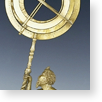
Galileo's last pupil, Vincenzo Viviani (1622-1703), collected and made mathematical instruments. He left his collection to the Hospital of Santa Maria Nuova, which in turn donated it to the Florentine Imperial and Royal Museum of Physics and Natural History. From here the collection went on to the University of Florence, and lastly to the Museo Galileo. A collection within a collection, it includes a variety of artifacts that reveal Viviani's particular interest in astronomy: the measurement of time and the structure of the universe according to the different cosmological systems debated in the 17th century.
Aristotelian planetarium
Inv. 2700
Maker unknown, Italian, ca. 1600
Declinatory
Inv. 1300
Maker unknown, Italian, 1671
Fragments of paper astrolabes
Inv. 1289bis
Maker unknown, Florence?, 17th cent.
Horary converter disk
Inv. 1287
Maker unknown, Italian, second half 17th cent.
Horary disk for constructing sundials
Inv. 1304
Maker unknown, Italian, 1672
Horizontal dial
Inv. 1283
Maker unknown, Italian, late 17th cent.
Model of the solar orb
Inv. 1290
Maker unknown, ca. 1575
Nocturnal
Inv. 1294
Simon Keill, 1647
Nocturnal
Inv. 1313
Maker unknown, Italian, first half 17th cent.
Nocturnal and sundial
Inv. 1286
Girolamo della Volpaia [attr.], Florence, 16th cent.
Plane astrolabe
Inv. 1289
Vincenzo Viviani [attr.], Italian, 1645
Plane astrolabe
Inv. 1282
Maker unknown, German, 16th cent.
Plane astrolabe
Inv. 1285
Maker unknown, Italian, 1568
Sundial
Inv. 1291, 1302
Maker unknown, German, ca. 1625-1630






















